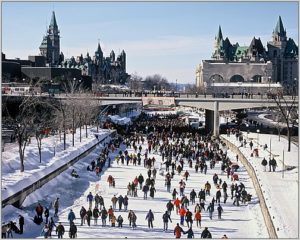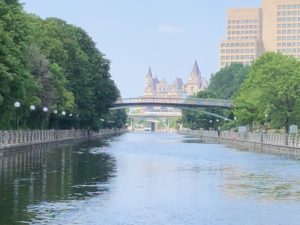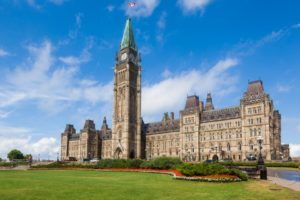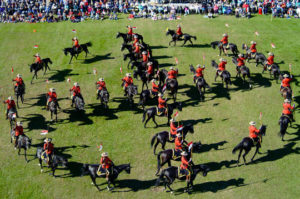
Skating on the Rideau Canal — one of Ottawa’s most popular winter pastimes. Photo from Canadian National Capital Commission.
Contributing writer Robert Waite, having led us on an odyssey through his recent (but pre-COVID) travels around the globe — including Laos, Cambodia, Albania, Namibia, and Rwanda — now appropriately turns his attentions to his sheltering home base: Ottawa, Canada.
I have fond memories of my own visits to Ottawa, even attempting to skate a stretch of the iced-over Rideau Canal during the annual Winterlude festival. Demonstrating my nearly non-existent ice-skating skills, I persevered all the way to our destination — which must have been at least 100 yards away (the length of an American football field!). Not bad for 45 minutes, eh?
However, as a confirmed arachnophobe, I may have to pass on the National Gallery of Canada on my next visit. To find out why and much more, read on:
By Robert Waite
Ottawa, Ontario – In 1857 Queen Victoria selected Ottawa to be the capital of what eventually became Canada. Her motive in picking a site so far north was said to be a fear of American invasion.
It seems to have worked. According to a survey conducted for the Association of Canadian Studies a few years ago, less than half the American population could identify Ottawa as Canada’s capital. Hard to invade a place you can’t find on a map.

The Rideau Canal in summer. Photo by Robert Waite.
Much like Schuyler sister Peggy in the hit musical “Hamilton” — who quickly fades to obscurity, overpowered by the radiant light thrown off by siblings Angelica and Eliza — Ottawa often plays third-fiddle to more glamorous nearby cities like Toronto and Montreal.
Which is too bad, since Ottawa has a lot to offer. For those looking for post-pandemic travel options that don’t require venturing outside North America, the city is accessible and relatively safe. And, if you are American, your dollar is worth about $1.35 Canadian!
Tranquil Excitement?
Ottawa has been my home for 15 years. This after something of a nomadic existence that included stops in places like San Francisco, New York, Nashville, Warsaw, Colchester, Madison, Washington, D.C., and Toronto.
I came here to take up a job. I stayed because it proved to have the right balance between occasional excitement and overall tranquility.
The tranquility is partly a function of size – the city itself has about 900,000 inhabitants. Ordnances have limited high-rise buildings and civil service salaries and pensions have created a solid economic base. The result is a very livable place.
The excitement part of the equation might come as a bit of a surprise, even to most Canadians. After all, for years Canadian comedians have touted the city as the place “where fun went to die.”
But there is much to do and see here. Let me share some of my favorites.
Museums With Flair
As one might expect of a national capital, Ottawa has a number of museums. What sets them apart is their content and, in many instances, their architectural flair.
* The Canadian Museum of History, designed by renowned aboriginal architect Douglas Cardinal, has a stunning Grand Hall evocative of a massive overturned canoe.

Parliament Hill in Ottawa. Photo credit: Government of Canada.
Inside you will find exhibits depicting Canada’s rich and varied human history, starting in The First People’s Hall. Of particular interest are the depictions of the lives and artifacts of the indigenous inhabitants of Canada’s west coast, including the Haida.
* The Canadian War Museum, designed by Canadian-Japanese architect Raymond Moriyama, utilizes textured concrete walls and a roof that is reminiscent of a WWI bunker. The current building was opened in 2005 and houses all manner of exhibits relating to Canada’s considerable military contributions over the years.
Most Americans are surprised to learn that Canada was involved far longer, both in World War I and World War II, than their southern neighbors – in aggregate, almost five years longer. Exhibits include a claustrophobic WWI trench and an impressive amount of military hardware arrayed across an expansive display space.
* The National Gallery of Canada is the nation’s art museum. It was designed by another great Canadian architect, Moshe Safdie, and opened in 1988.
Working in glass, steel and concrete, Safdie took as his inspiration the nearby spires of Parliament Hill, but substituted a more airy, modern aesthetic for the Parliament’s Centre Block Gothic treatment. (Parliament Hill itself is currently closed for two years for refurbishment.)
Inside, visitors will find a rich display of Canadian art from various periods, including Ontario’s celebrated Group of Seven and B.C.’s Emily Carr, as well as prominent 18th and 19th century Quebec artists. Indigenous artists, including the Inuit of the far north, are represented as well.

Barack Obama enjoyed his visit to the Byward Market and the fried dough at Beaver Tails. Photo credit:CBC
Outside, those suffering arachnophobia may be alarmed by a gigantic spider sculpture. (Oddly, a smaller replica can be found on the campus of the University of North Carolina in Chapel Hill.)
* The Museum of Nature, which depicts fauna both ancient (dinosaurs) and contemporary (moose), is worth a visit, especially if you have kids or grand-kids in tow. Speaking of dinosaurs, the building also once housed Parliament when Canada’s Parliament Building was destroyed by fire in 1916.
Winterlude and Other Festivals
Ottawa isn’t much for professional sports – there is a pretty bad NHL team; a pretty good CFL football team; and a long-departed Triple A baseball franchise – but makes up for it with cultural activities.
There are a number of theaters, French and English, plus any number of festivals, from Jazz to Blues, to Tulips.
Probably the best known is Winterlude, which runs through three weekends in February. Most activities are held on and around the Rideau Canal, a UNESCO World Heritage Site that is billed as the world’s largest skating venue.
Outdoor Attractions
Ottawa has much to do and see in the great outdoors. As mentioned, there is the Rideau Canal, built to connect Lake Ontario to the Ottawa River (and, ultimately, Ottawa to Montreal, the St. Lawrence River, and the Atlantic). Boat tours are popular and fun and allow you to see the city from a different vantage point.
The Byward Market is also popular, especially in the summer. In addition to being an outdoor farmer’s market, there are numerous restaurants and bars in the area. Plus there’s a Beaver Tails shop, serving up a fried dough concoction with your choice of topping – it was a big hit with U.S. President Obama when he visited.
Also outdoors is Gatineau Park, located across the river in Quebec. Its hilly terrain is great for hiking, cycling and, in the fall, for viewing stunning foliage. In winter you can explore extensive cross-country skiing trails.
Hidden Gems

The Royal Canadian Mounted Police form a wheel. Photo credit: Government of Canada.
Everyone has heard of the Royal Canadian Mounted Police, but you probably haven’t gotten up close and personal with the horses. You can do so at the RCMP Stables and Visitor Centre. Tours take place every half hour during the summer (and on Tuesday and Thursday during winter months) and are free.
Another place worth a look is the Central Experimental Farm, which features ornamental gardens, an arboretum and an Agriculture and Food Museum. The complex sits on 65 acres a little south of the city’s downtown.
In short, Ottawa offers much to do in a very pleasant, uncongested setting. It’s the perfect place to chase away those COVID blues. Plus you’ll be able to correctly identify the capital of Canada, should a pollster ask.
IF YOU GO
Ottawa can be reached by air from several U.S. cities, including Boston, New York, Washington, D.C., and Chicago.
My choice of a place to stay is the Chateau Laurier, one of Canada’s classic French chateau-style railway properties. The Westin and Lord Elgin are also centrally located and good choices.
The best times to visit are the summer, autumn and winter. Spring comes late and is often a sloppy mess – for that reason I would steer clear of the May Tulip Festival.
There are several good dining options in and near Ottawa. In the city itself, Beckta is a consistent award winner known for its eclectic offerings, extensive wine list and high service levels. For those seeking a bit of political history (and pretty good Italian fare) there is Mama Theresa’s – you can stare at photos of various luminaries while waiting to be seated. If you hanker for French-Canadian cuisine, your best bet is Les Fougeres, located about 20 minutes away in Chelsea, Quebec.
Author Bio: Robert Waite has written on travel for almost 50 years. A former Pacific News Service correspondent, he is a professor at Seneca College in Toronto and Managing Partner at Waite + Co., a communications consulting firm with offices in Boston, Ottawa and Toronto.
You might also enjoy these other posts about Canada by Robert Waite:












Leave a Reply